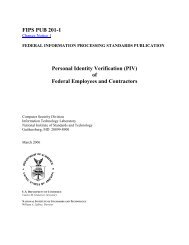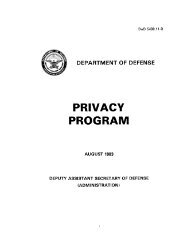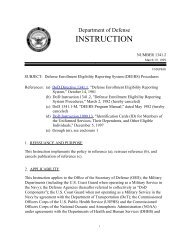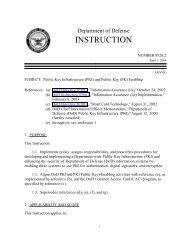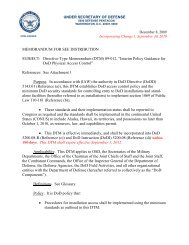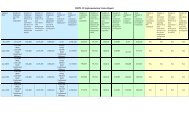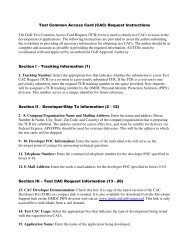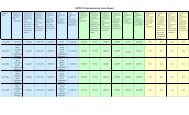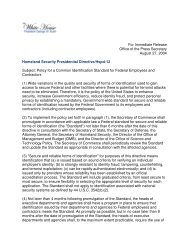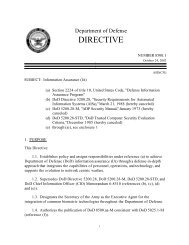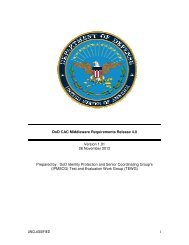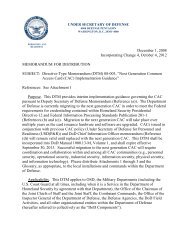DoD Instruction 8500.2 - Common Access Card (CAC)
DoD Instruction 8500.2 - Common Access Card (CAC)
DoD Instruction 8500.2 - Common Access Card (CAC)
You also want an ePaper? Increase the reach of your titles
YUMPU automatically turns print PDFs into web optimized ePapers that Google loves.
DODI <strong>8500.2</strong>, February 6, 2003<br />
Subject<br />
Area<br />
Control Number, Name and Text<br />
Identification and Authentication<br />
IAIA-2<br />
Individual Identification and Authentication<br />
<strong>DoD</strong> information system access is gained through the presentation of an individual<br />
identifier (e.g., a unique token or user logon ID) and password. For systems utilizing a<br />
logon ID as the individual identifier, passwords are, at a minimum, a case sensitive,<br />
8-character mix of upper case letters, lower case letters, numbers, and special<br />
characters, including at least one of each (e.g., emPagd2!). At least four characters<br />
must be changed when a new password is created. Deployed/tactical systems with<br />
limited data input capabilities implement these measures to the extent possible.<br />
Registration to receive a user ID and password includes authorization by a supervisor,<br />
and is done in person before a designated registration authority. Multiple forms of<br />
certification of individual identification such as a documentary evidence or a<br />
combination of documents and biometrics are presented to the registration authority.<br />
Additionally, to the extent capabilities permit, system mechanisms are implemented to<br />
enforce automatic expiration of passwords and to prevent password reuse, and<br />
processes are in place to validate that passwords are sufficiently strong to resist<br />
cracking and other attacks intended to discover a user's password. All factory set,<br />
default or standard-user IDs and passwords are removed or changed. Authenticators<br />
are protected commensurate with the classification or sensitivity of the information<br />
accessed; they are not shared; and they are not embedded in access scripts or stored<br />
on function keys. Passwords are encrypted both for storage and for transmission.<br />
Identification and Authentication<br />
IAKM-3<br />
Key Management<br />
Symmetric and asymmetric keys are produced, controlled and distributed using<br />
NSA-approved key management technology and processes.<br />
Enclave and Computing Environment<br />
ECAD-1<br />
Affiliation Display<br />
To help prevent inadvertent disclosure of controlled information, all contractors are<br />
identified by the inclusion of the abbreviation "ctr" and all foreign nationals are identified<br />
by the inclusion of their two character country code in:<br />
- <strong>DoD</strong> user e-mail addresses (e.g., john.smith.ctr@army.mil or<br />
john.smith.uk@army.mil);<br />
- <strong>DoD</strong> user e-mail display names (e.g., John Smith, Contractor<br />
or John Smith, United Kingdom );<br />
and<br />
- automated signature blocks (e.g., John Smith, Contractor, J-6K, Joint Staff or John<br />
Doe, Australia, LNO, Combatant Command).<br />
Contractors who are also foreign nationals are identified as both (e.g.,<br />
john.smith.ctr.uk@army.mil).<br />
Country codes and guidance regarding their use are in FIPS 10-4.<br />
IA Service<br />
Confidentiality<br />
Integrity<br />
Confidentiality<br />
86 ENCLOSURE 4, ATTACHMENT 4



